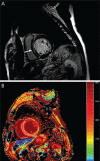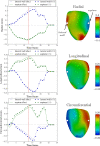Cardiac MRI for Patients with Increased Cardiometabolic Risk
- PMID: 33969314
- PMCID: PMC8098096
- DOI: 10.1148/ryct.2021200575
Cardiac MRI for Patients with Increased Cardiometabolic Risk
Abstract
Cardiac MRI (CMR) has rich potential for future cardiovascular screening even though not approved clinically for routine screening for cardiovascular disease among patients with increased cardiometabolic risk. Patients with increased cardiometabolic risk include those with abnormal blood pressure, body mass, cholesterol level, or fasting glucose level, which may be related to dietary and exercise habits. However, CMR does accurately evaluate cardiac structure and function. CMR allows for effective tissue characterization with a variety of sequences that provide unique insights as to fibrosis, infiltration, inflammation, edema, presence of fat, strain, and other potential pathologic features that influence future cardiovascular risk. Ongoing epidemiologic and clinical research may demonstrate clinical benefit leading to increased future use. © RSNA, 2021.
2021 by the Radiological Society of North America, Inc.
Conflict of interest statement
Disclosures of Conflicts of Interest: C.P. disclosed no relevant relationships. R.S. disclosed no relevant relationships. P.P. disclosed no relevant relationships. R.L. disclosed no relevant relationships. K.S. disclosed no relevant relationships. M.S.B. Activities related to the present article: disclosed no relevant relationships. Activities not related to the present article: author’s institution has grants/grants pending from Sanofi; author received payment for lectures including service on speakers bureaus from EMS, Novo Nordisk, Boston Scientific, and GE Healthcare. Other relationships: disclosed no relevant relationships. E.A.H. Activities related to the present article: disclosed no relevant relationships. Activities not related to the present article: author has volunteer consultation with the Defense Health Agency and Department of Defense Cardiovascular Clinical and Imaging workgroups, volunteer activity with Society of Cardiac Computed Tomography, American Society of Nuclear Cardiology, Society of Cardiac MRI, and Society of Nuclear Medicine and Molecular Imaging; editorial board membership with ACC Cardiosmart, SCMR, and Atherosclerosis. Other relationships: disclosed no relevant relationships.
Figures










Similar articles
-
Effect of cardiometabolic risk factors on the relationship between adiposity and bone mass in girls.Int J Obes (Lond). 2018 Jun;42(6):1185-1194. doi: 10.1038/s41366-018-0134-x. Epub 2018 Jun 11. Int J Obes (Lond). 2018. PMID: 29892038 Free PMC article.
-
The association between screen time and cardiometabolic risk in young children.Int J Behav Nutr Phys Act. 2020 Apr 29;17(1):41. doi: 10.1186/s12966-020-00943-6. Int J Behav Nutr Phys Act. 2020. PMID: 32345327 Free PMC article.
-
[Pharmacological therapy of obesity].G Ital Cardiol (Rome). 2008 Apr;9(4 Suppl 1):83S-93S. G Ital Cardiol (Rome). 2008. PMID: 18773755 Italian.
-
Cardiovascular Magnetic Resonance of Myocardial Fibrosis, Edema, and Infiltrates in Heart Failure.Heart Fail Clin. 2021 Jan;17(1):77-84. doi: 10.1016/j.hfc.2020.08.013. Epub 2020 Oct 28. Heart Fail Clin. 2021. PMID: 33220888 Review.
-
[Cardiovascular risk and cardiometabolic risk: an epidemiological evaluation].G Ital Cardiol (Rome). 2008 Apr;9(4 Suppl 1):6S-17S. G Ital Cardiol (Rome). 2008. PMID: 18773746 Review. Italian.
Cited by
-
Advances in TEE-Centric Intraprocedural Multimodal Image Guidance for Congenital and Structural Heart Disease.Diagnostics (Basel). 2023 Sep 18;13(18):2981. doi: 10.3390/diagnostics13182981. Diagnostics (Basel). 2023. PMID: 37761348 Free PMC article. Review.
-
The impact of severe obesity on image quality and ventricular function assessment in echocardiography and cardiac MRI.Int J Cardiovasc Imaging. 2024 May;40(5):1081-1094. doi: 10.1007/s10554-024-03078-y. Epub 2024 Apr 16. Int J Cardiovasc Imaging. 2024. PMID: 38625629 Free PMC article.
References
-
- Sidney S, Quesenberry CP Jr, Jaffe MG, et al. . Recent Trends in Cardiovascular Mortality in the United States and Public Health Goals. JAMA Cardiol 2016;1(5):594–599. - PubMed
-
- Townsend N, Wilson L, Bhatnagar P, Wickramasinghe K, Rayner M, Nichols M. Cardiovascular disease in Europe: epidemiological update 2016. Eur Heart J 2016;37(42):3232–3245. - PubMed
-
- Grundy SM, Brewer HB Jr, Cleeman JI, et al. . Definition of metabolic syndrome: Report of the National Heart, Lung, and Blood Institute/American Heart Association conference on scientific issues related to definition. Circulation 2004;109(3):433–438. - PubMed
LinkOut - more resources
Full Text Sources
Other Literature Sources

